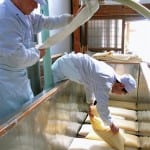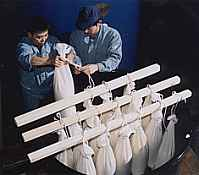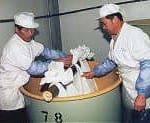 One of the biggest factors contributing to the quality of the sake from a given kura is the skill of the toji, or master brewer, in residence therein. And while technical texts and other means of advice and support are much more available to brewers today then, say a century ago, the experience, intuition, and decisiveness of the person in charge is still of paramount importance.
One of the biggest factors contributing to the quality of the sake from a given kura is the skill of the toji, or master brewer, in residence therein. And while technical texts and other means of advice and support are much more available to brewers today then, say a century ago, the experience, intuition, and decisiveness of the person in charge is still of paramount importance.
It is probably fair to say, though, that the industry is less dependent on the various guilds of master brewers than they were back in the old days. And in fact, I myself have been seeing less (not zero, mind you, but less) significance in the differences between the various guilds themselves, beyond their formidable cultural and historical presence.
Sure, we hear about slight differences, like the Nanbu guild does it this way, but the Echigo guild does the same step another way. But in the end, the overall level of technical prowess is higher than it used to be, toji or no toji, guild or no guild. And so many other factors guide the decisions of any given toji – such as house style or modern consumer needs – that those little differences between the guilds get squashed in comparison.
Nevertheless, I am pretty sure there is a lot about sake brewing about which I have no clue, and recently learned a bit about some of the real technical differences in the way different guilds of toji brew, and teach their protégé.
The toji guilds are centered around old farming regions, and most of the toji of a particular guild would  stay close to home. But as the number of guilds and therefore toji has declined drastically (many are gone for good, or have but a couple of members), those that have maintained their numbers begin to necessarily spread out a bit, practicing their craft in kura farther and farther from their main region. Also, as there are textbooks, computers and seminars these days, the differences between the gilds is less clear cut than it used to be, in terms of technology, methods, and logistics.
stay close to home. But as the number of guilds and therefore toji has declined drastically (many are gone for good, or have but a couple of members), those that have maintained their numbers begin to necessarily spread out a bit, practicing their craft in kura farther and farther from their main region. Also, as there are textbooks, computers and seminars these days, the differences between the gilds is less clear cut than it used to be, in terms of technology, methods, and logistics.
And so I found myself in Ishikawa Prefecture, on the Noto Peninsula, home to the Noto Toji Guild. It is a narrow strip of land so sparsely populated, mostly with tobacco farmers, that in some higher spots one can see water on both sides, a testament to how few buildings there are.
One brewer I was visiting, a tiny operation, had as their toji the son of the owner, destined to take over himself in due time. But oddly enough, due to some affiliation from university, he was affiliated with a totally different guild, the mighty Nanbu Guild, basically centered in Iwate way up north.
So here sat this Nanbu toji in the middle of the home town of Noto toji. While it may not seem like much in writing, I was surprised and impressed. In any event, this particular gent had the chance to speak with many a Noto Toji as he was surrounded by them, and that juxtaposition made for great conversation as we strolled around his kura.
I found one particular technical difference big enough to surprise me and encourage further discussion.
 When brewing a tank of sake, after the yeast starter is prepared, it is mixed with more rice, enzyme-rich moldy rice called koji, and water, added in three separate doses over four days. After that, the resulting fermenting mash – called the moromi – is allowed to ferment away for from 20 to 35 days or so. As it goes about its fermenting business, the temperature in that tank will rise. The highest temperature it reaches can be anywhere from 10C to 18C, depending on the grade of sake and ten million other things.
When brewing a tank of sake, after the yeast starter is prepared, it is mixed with more rice, enzyme-rich moldy rice called koji, and water, added in three separate doses over four days. After that, the resulting fermenting mash – called the moromi – is allowed to ferment away for from 20 to 35 days or so. As it goes about its fermenting business, the temperature in that tank will rise. The highest temperature it reaches can be anywhere from 10C to 18C, depending on the grade of sake and ten million other things.
It was explained to me by this Nanbu Toji surrounded by Noto Toji that the Nanbu guild liked to let that temperature run up freely and of its own accord. “It gives us the fine-grained, clear flavor we are famous for,” he explained. But the Noto guild prefers to hold that back, forcing the moromi to take as much time as is feasible to come up to that higher temperature. The words used to me were, “Osaete, osaete,” or “They hold it back, as if saying ‘Easy now, killer, easy now.’” As he explained to me, he held his arms out, palms facing me and pushing forward, as if holding back an invisible force. And again, there is a reason. “It gives them the full flavor and quick finish that is their trademark,” I was told.
The differences are quite significant. We’re not talking a day or two here, but more to the tune of a seven days. In other words, one school says the highest temperature can be hit in a week, another says hold it back and make it take 14 days or so. To me, having that much variance in the basic brewing methodology is surprising.
But they’re right. If left on their own to brew sake as they like (i.e. without owner or consumer “suggestions” or “guidance”), Nanbu toji-brewed sake is indeed clear and fine-grained. And without a doubt, Noto toji-made juice is quite full – until the end, when it cleans out astonishingly quickly.
Well, I initially chalked this up to his particular perception. But the next day I had the good fortune to visit another brewery, this one firmly ensconced in the region’s Noto toji hands. And as the evening’s discussion with that toji wore on, we returned to this point.
I began to describe to him what I had been told. “I have heard that the Nanbu toji let the temperature of the moromi run up freely, whereas you Noto guys tend to?” He cut me off at that point.
With his arms out, palms pushing toward me as if holding back an invisible force, he interjected “Osaete, osaete?” And added a bit more verbiage to the tune of “Easy now, killer, easy now. Gotta hold that puppy back a bit.” Not only did he know where I was going, the very words were the same. The gestures were too, for that matter. This kind of indicated to me just how deeply ingrained their thinking is on the issue. “It’s what gives our sake the full flavor yet clean finish Noto Toji are known for.”
I was impressed by not only the differences, but also by the acute awareness of those differences on the part of the journeymen themselves.
I reiterate, though, that these differences are likely less significant than they once were. Textbooks, computer-generated curves and the equipment to allow brewers to match them, and modern understanding of the processes have usurped much of the effect of those older, empirically driven methods. But still, the differences in the practices of the various toji guilds are alive, well, and infinitely interesting.
~~~~~~~~~~~~~~~~~~~~~~~~~~~~~~~~~~~
 Interested in Sake? Pick up a copy of my latest book, Sake Confidential, A Beyond-the-Basics Guide to Understanding, Tasting, Selection, and Enjoyment.
Interested in Sake? Pick up a copy of my latest book, Sake Confidential, A Beyond-the-Basics Guide to Understanding, Tasting, Selection, and Enjoyment.
Learn more here.




